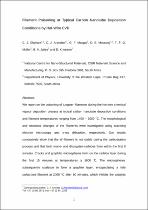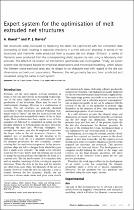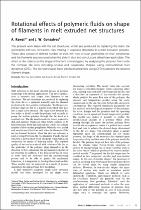 ResearchSpace
ResearchSpace
Filament poisoning at typical carbon nanotube deposition conditions by hot-filament CVD
JavaScript is disabled for your browser. Some features of this site may not work without it.
- ResearchSpace
- →
- Research Publications/Outputs
- →
- Journal Articles
- →
- View Item
| dc.contributor.author |
Oliphant, CJ

|
|
| dc.contributor.author |
Arendse, CJ

|
|
| dc.contributor.author |
Malgas, GF

|
|
| dc.contributor.author |
Motaung, DE

|
|
| dc.contributor.author |
Muller, TFG

|
|
| dc.contributor.author |
Halindintwali, S

|
|
| dc.contributor.author |
Julies, BA

|
|
| dc.contributor.author |
Knoesen, D

|
|
| dc.date.accessioned | 2009-11-12T10:54:57Z | |
| dc.date.available | 2009-11-12T10:54:57Z | |
| dc.date.issued | 2009-05 | |
| dc.identifier.citation | Oliphant, CJ, Arendse, CJ, Malgas, GF et al. 2009. Filament poisoning at typical carbon nanotube deposition conditions by hot-filament CVD. Journal of Materials Science, Vol. 44(10), pp 2610-2616 | en |
| dc.identifier.issn | 0022-2461 | |
| dc.identifier.uri | http://hdl.handle.net/10204/3727 | |
| dc.identifier.uri | http://www.springerlink.com/content/9662347m4r726532/fulltext.pdf | en |
| dc.description | Copyright: 2009 Springer-Verlag. This is the author's version of the work. It is posted here by permission of Springer-Verlag for your personal use. Not for redistribution. The definitive version was published in the Journal of Materials Science, Vol. 44(10), pp 2610-2616 | en |
| dc.description.abstract | This paper reports on the poisoning of tungsten filaments during the hot-filament chemical vapour deposition process at typical carbon nanotube (CNT) deposition conditions and filament temperatures ranging from 1400 to 2000 °C. The morphological and structural changes of the filaments were investigated using scanning electron microscopy and X-ray diffraction, respectively. Results conclusively show that the W-filament is not stable during the carburization process and that both mono- and ditungsten-carbides form within the first 5 min. Cracks and graphitic microspheres form on the carbide layer during the first 15 min at the temperatures =1600 °C. The microspheres subsequently coalesce to form a graphite layer, encapsulating a fully carburized filament at the temperature of 2000 °C after 60 min, which inhibits the catalytic activity of the filament to produce atomic hydrogen. The structural changes of the filament also induce variations in its temperature, illustrating the instability of the filament during the deposition of CNTs | en |
| dc.language.iso | en | en |
| dc.publisher | Springer - Verlag | en |
| dc.subject | Filament poisoning | en |
| dc.subject | Carbon nanotube deposition | en |
| dc.subject | Hot-filament CVD | en |
| dc.subject | Hot-filament chemical vapour deposition | en |
| dc.subject | HFCVD | en |
| dc.subject | Tungsten filaments | en |
| dc.subject | Morphology | en |
| dc.subject | Material science | en |
| dc.title | Filament poisoning at typical carbon nanotube deposition conditions by hot-filament CVD | en |
| dc.type | Article | en |
| dc.identifier.apacitation | Oliphant, C., Arendse, C., Malgas, G., Motaung, D., Muller, T., Halindintwali, S., ... Knoesen, D. (2009). Filament poisoning at typical carbon nanotube deposition conditions by hot-filament CVD. http://hdl.handle.net/10204/3727 | en_ZA |
| dc.identifier.chicagocitation | Oliphant, CJ, CJ Arendse, GF Malgas, DE Motaung, TFG Muller, S Halindintwali, BA Julies, and D Knoesen "Filament poisoning at typical carbon nanotube deposition conditions by hot-filament CVD." (2009) http://hdl.handle.net/10204/3727 | en_ZA |
| dc.identifier.vancouvercitation | Oliphant C, Arendse C, Malgas G, Motaung D, Muller T, Halindintwali S, et al. Filament poisoning at typical carbon nanotube deposition conditions by hot-filament CVD. 2009; http://hdl.handle.net/10204/3727. | en_ZA |
| dc.identifier.ris | TY - Article AU - Oliphant, CJ AU - Arendse, CJ AU - Malgas, GF AU - Motaung, DE AU - Muller, TFG AU - Halindintwali, S AU - Julies, BA AU - Knoesen, D AB - This paper reports on the poisoning of tungsten filaments during the hot-filament chemical vapour deposition process at typical carbon nanotube (CNT) deposition conditions and filament temperatures ranging from 1400 to 2000 °C. The morphological and structural changes of the filaments were investigated using scanning electron microscopy and X-ray diffraction, respectively. Results conclusively show that the W-filament is not stable during the carburization process and that both mono- and ditungsten-carbides form within the first 5 min. Cracks and graphitic microspheres form on the carbide layer during the first 15 min at the temperatures =1600 °C. The microspheres subsequently coalesce to form a graphite layer, encapsulating a fully carburized filament at the temperature of 2000 °C after 60 min, which inhibits the catalytic activity of the filament to produce atomic hydrogen. The structural changes of the filament also induce variations in its temperature, illustrating the instability of the filament during the deposition of CNTs DA - 2009-05 DB - ResearchSpace DP - CSIR KW - Filament poisoning KW - Carbon nanotube deposition KW - Hot-filament CVD KW - Hot-filament chemical vapour deposition KW - HFCVD KW - Tungsten filaments KW - Morphology KW - Material science LK - https://researchspace.csir.co.za PY - 2009 SM - 0022-2461 T1 - Filament poisoning at typical carbon nanotube deposition conditions by hot-filament CVD TI - Filament poisoning at typical carbon nanotube deposition conditions by hot-filament CVD UR - http://hdl.handle.net/10204/3727 ER - | en_ZA |








